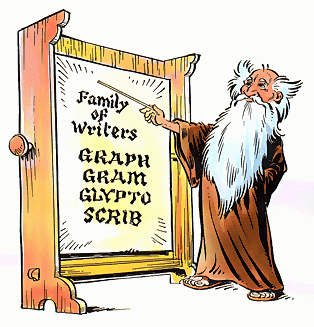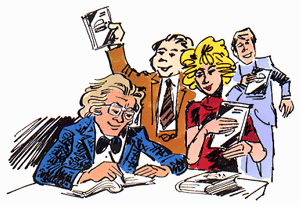Grapho- Words Meaning Write, Record: “labiograph” to “nyctograph”,
Part 7 of 11.
Words that include: grapho-, graph-, -graph, -graphy,
-grapher, -graphia
(Greek: to scratch; write, record, draw, describe).

labiograph:
An instrument for recording the movements of the lips in speaking.
laryngograph:
An instrument for making a tracing of the movements of the vocal folds.
lexicographer:
One who compiles a dictionary or dictionaries.
A writer of dictionaries, a harmless drudge.
—Samuel Johnson (1709-1784)
lexicography, lexicograph, lexicographic:
The writing or compilation of a lexicon or dictionary; the art or practice of writing or compiling dictionaries.
Sir, no man but a blockhead ever wrote
except for money.
—Samuel Johnson (1709-1784)
lexigraphy, lexigraphic:
A system of writing in which each character represents a word.
lignography:
Wood engraving.
limnograph:
An apparatus for automatically recording the variations of levels in a lake.
lipography:
The avoidance of a certain letter or syllable in a text.
lithography, lithograph, lithographic:
1. A description of stones or rocks.
2. The art of engraving on precious stones.
3. The art or process of making a drawing, design, or writing on a special kind of stone (called lithographic stone), so that impressions in ink can be taken from it. Also, a planographic printing process using metal or plastic plates with a sensitized coating on which the matter to be printed is fixed chemically, before the non-printing areas of the plates are dampenedd and the remainder printed with greasy inks on flat-bed or cylinder presses.
logographer:
1. A story writer: short-story, novelist, etc. 2 A writer of spoken language in longhand as opposed to shorthand.
3. A prose writer in ancient Greece.

logography, logograph, logographic:
1. A method of reporting spoken language in longhand; especially, one using several reporters taking down a few words in succession.
2. The art of arranging letters for printing.
3. A
logograph is also defined as a sign or symbol used to represent a word; such as, ‰, ¢, $, £, ¥, and &.
Logographic writing systems are those where the graphemes represent words. This is particularly true with Chinese, and its derivative script, Japanese kanji. The symbols are variously referred to as logographs, logograms, or characters.
macrography, megalographia:
Abnormally large handwriting, often the result of a nervous disorder in the writer.
macrophotography:
Photography in which objects are reproduced larger than or at their actual size but without the degree of magnification that use of a microscope would give.
mammography:
Imaging examination of the breast by means of x-rays, ultrasound, and nuclear magnetic resonance; used for screening and diagnosis of breast disease.
marigraph, marigraphic:
An instrument for automatically recording the rise and fall of the tide; a tide-gauge.
mechanography, mechanographic:
The art of copying or reproducing a work of art or writing by mechanical means.
metallography, metallographic:
1. A treatise or description of metals.
2. The descriptive science relating to the internal structure of metals.
3. A printing-process akin to lithography, in which metal plates are used instead of stones.
meteorography, meteorographic, meteorographical:
The descriptive science of meteors, or of meteorological phenomena.
micrography, micrograph, micrographic:
1. An apparatus used for miniature writing or drawing.
2. The art or technique of writing with extremely small characters.
3. In psychiatry, abnormally small handwriting, as a symptom of a nervous disorder.
4. An instrument that magnifies the microscopic movements of a diaphragm by means of light interference and records them on a moving photographic film; may be used for recording various pulse curves, sound waves, and any forms of motion that may be communicated through the air to a diaphragm.
microtopography, microtopographic, microtopographical:
The surface features of a material, or of the earth or other body, on a small or microscopic scale.
mimeography, mimeograph, mimeographic:
Literally: Greek mimeomai, “I imitate” + graph, “write”. A machine for reproducing copies of written, drawn, or typewritten pages by means of a stencil placed around a drum containing ink.
mogigraphy, mogigraphia, mogigraphic:
1. Physical difficulty in writing which may be a result of clumsiness of the fingers.
2. Difficult or cramped writing; writer’s cramp.
monograph, monographic:
Once applied to a treatise on some special subject in other departments of knowledge; also a monogram.
morphography, morphographic, morphographical:
The scientific description of form.
museographer, museographist:
Someone who systematically describes the contents of museums.
museography, museographic, museoographical:
The systematic description of the contents of museums.
musicography, musicographic, musicographical:
The science or art of writing music; musical notation.
myelography, myelographic:
In medicine, radiography of the spinal chord after injection of a contrast medium (often air) into the subarachnoid space.
myographer, myographist:
In medicine, one who is skilled in myography.
myography:
In medicine, a description of muscles; the descriptive science of muscles.
mythography:
1. A collection of myths.
2. The representation of a mythical subject in a work of art.
neography:
A new or novel way of writing.
neophrography:
The scientific description of the kidneys.
neurography, neurograph, neurographic:
1. A scientific description of the nerves; descriptive neurology.
2. A name proposed for: all the neurograms of an individual, considered collectively.
noctograph:
A writing frame designed for use by blind people.
nomographer:
A writer of laws; a legislator.
nomography, nomograph, nomographic:
The expression of law in written form.
nosographer:
One who writes systematic descriptions of diseases.
nosography, nosographic:
1. A systematic description of diseases.
2. Assignment of names to each disease entity in a group that has been classified according to a systematic nosology.
3. A treatise on pathology or the practice of medicine.
numismatography:
The systematic description of coins; the descriptive part of numismatics.
nyctograph:
A device invented by Lewis Carroll with which one can record one’s ideas at night, in the dark, or when not fully awake.